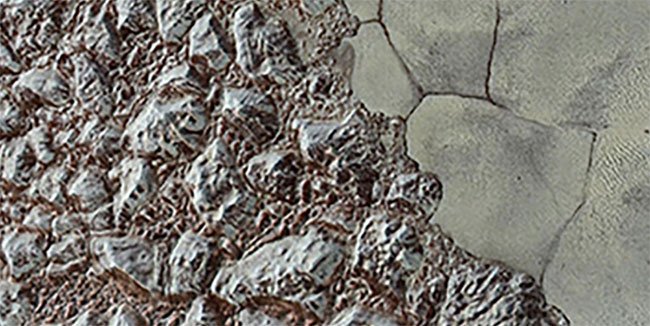Pluto has a vast ocean for the past 4.5 billion years
Image analysis from NASA's New Horizons mission shows Pluto is very hot when it is first formed. This will create liquid water that exists to this day.
Scientists say the dwarf planet is hot when it is first formed, and water may lie beneath the icy crust, which may contain life.
The discovery is important for considering the potential habitation of other icy worlds that may also contain hidden oceans and perhaps aliens.

The image shows the icy surface of Pluto.
Planetary scientist Carver Bierson said: " Even in a cold environment away from the Sun, all of these worlds could have formed hot and hot with liquid oceans."
Pluto was previously thought to start as a solid snowball and then began to slowly melt over time due to radioactive decay.
'Pluto has had an ocean that is slowly freezing for all Solar System history. We are fairly certain that water is one of the ingredients for life. Having the surrounding water longer will allow it to react to the underlying rock core, providing more chemicals , ' Carver Bierson said.
The team at the University of California compared the geological observations of 2015 with thermal modeling simulations of Pluto's evolution.
As one of the first research authors, Carver Bierson said: "By examining the characteristics of Pluto today, we can begin to understand its birth 4.5 billion years ago. years ago with glaciers higher than 3km to smooth plains and dunes'.
As Pluto is building new blocks of ice and ice are falling. Each impact is like an explosion that will warm the nearby area. If Pluto formed slowly, the surface could cool between bumps.
Research shows that Pluto formed quickly, in less than 30,000 years. The ice was so warm that it began to melt. After a while the initial melting, the ocean under the sea will be frozen.
Co-author, Professor Francis Nimmo adds: "The oldest surface features on Pluto are harder to find, but it seems that there is both an ancient and modern extension of the surface. shows that other objects on the edge of the Solar System have been hot with the oceans. Some can still be there today. "
- Traces of the vast ocean on Pluto's moon
- Discover the giant ocean on Pluto
- Is there an ocean hidden on Pluto?
- Scientists discover ocean on Pluto
- Tomorrow the New Horizons spacecraft approaches Pluto
- Pluto can form from one billion comets
- Journey to discover Pluto
- Doubt: There is life hiding on Pluto
- The probe goes halfway to Pluto
- Marvel at the substance found under Pluto
- Discover the mysterious ice lake on Pluto
- NASA continues to publish more new photos of Pluto
 Van Allen's belt and evidence that the Apollo 11 mission to the Moon was myth
Van Allen's belt and evidence that the Apollo 11 mission to the Moon was myth The levels of civilization in the universe (Kardashev scale)
The levels of civilization in the universe (Kardashev scale) Today Mars, the sun and the Earth are aligned
Today Mars, the sun and the Earth are aligned The Amazon owner announced a secret plan to build a space base for thousands of people
The Amazon owner announced a secret plan to build a space base for thousands of people Does the solar system have the 9th planet to own oceans and life?
Does the solar system have the 9th planet to own oceans and life?  Scientists discover ocean on Pluto
Scientists discover ocean on Pluto  The 5 'facts' you've ever learned in school turned out to be completely wrong
The 5 'facts' you've ever learned in school turned out to be completely wrong  What is the final border in science?
What is the final border in science?  Find 'hell gate' in myth
Find 'hell gate' in myth  Mysterious series of new mountains on Pluto are identified
Mysterious series of new mountains on Pluto are identified 